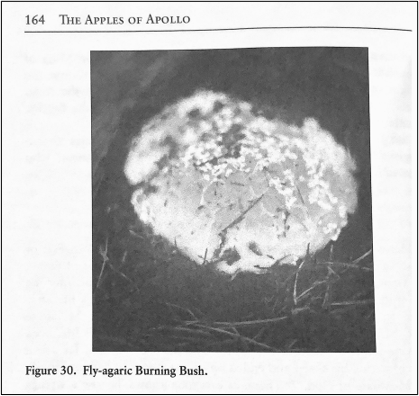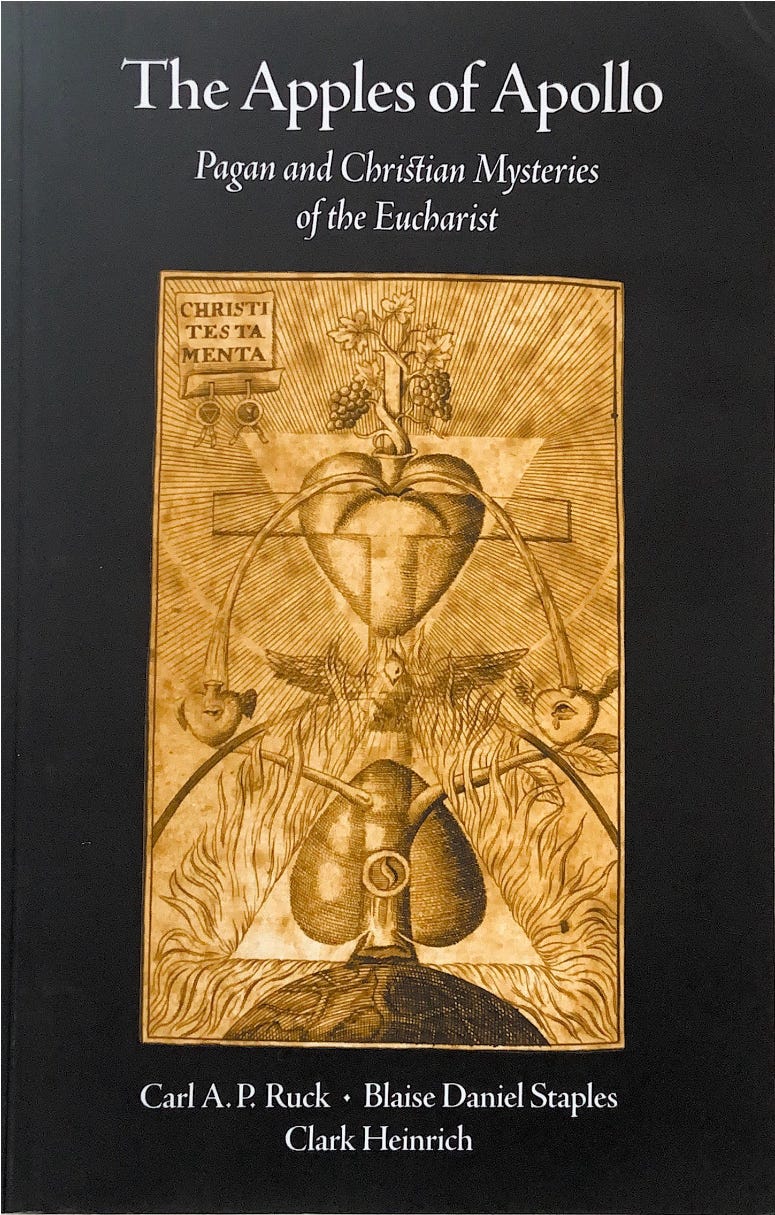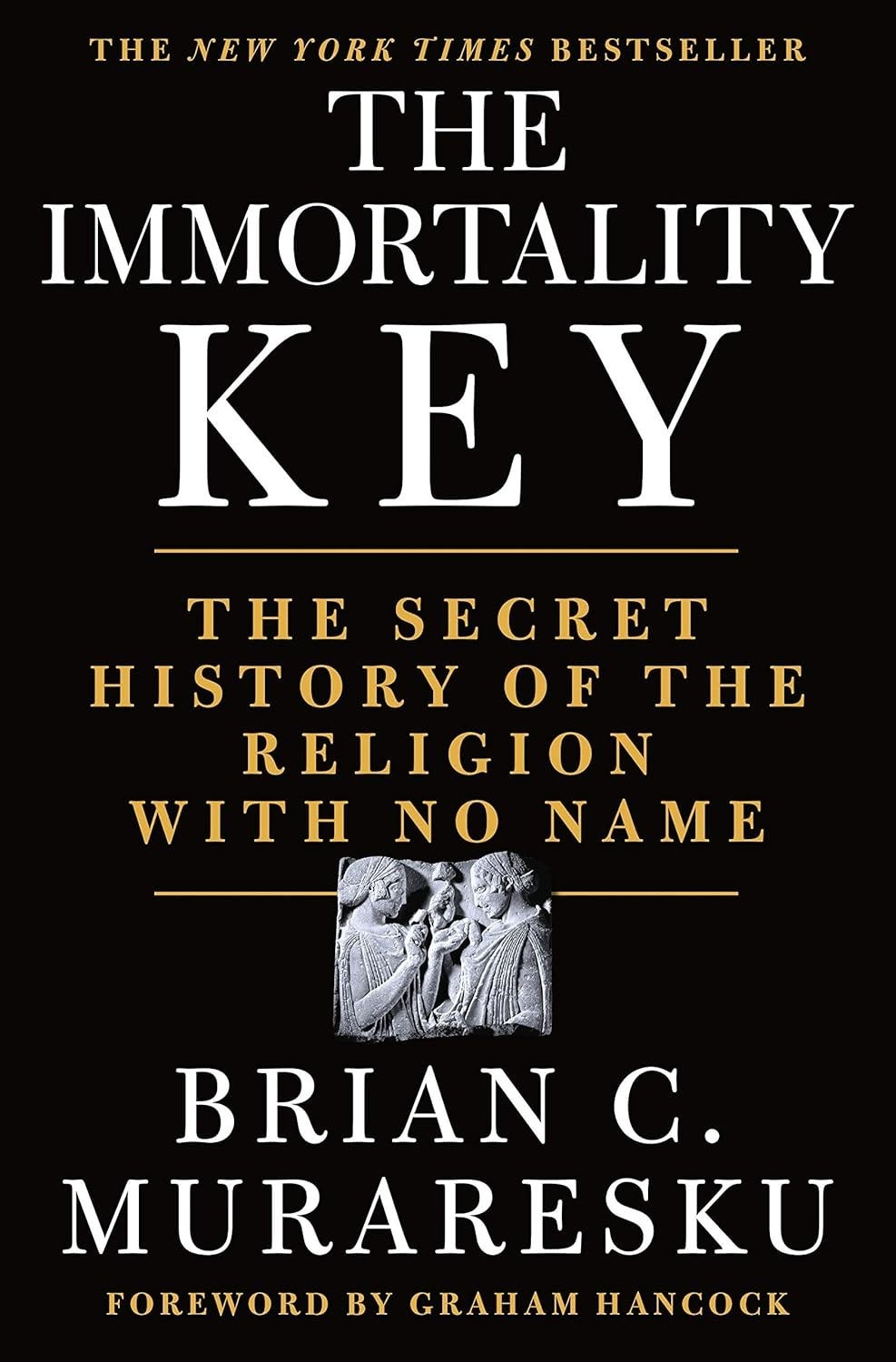In part one I told the tale of the maverick scholar of the Dead Sea Scrolls and discussed the central works of the small but influential industry of “entheogen” scholarship in ancient religion that emerged in the mid-late 20th century. The Road to Eleusis became the classic text. My intent was to chart a path towards a more recent book, a more recent author, and a re-vamped proposal that psychedelics were the root cause of early Christian spirituality.
(photo used with permission; see source)
Out of Eleusis and into the Church
The story starts up again with Carl Ruck. As a kind of successor to The Road to Eleusis, in 2001, Ruck and other authors published a work entitled The Apples of Apollo: Pagan and Christian Mysteries of the Eucharist. The connection to Allegro’s work is strong, and in a long-winded and winding chapter entitled “Jesus, the Drug Man,” Ruck and co. seek to re-establish Christianity as a mushroom cult. We are treated to this ominous prefatory note:
We are divulging secrets about Mysteries that (perhaps) still exist today, but the obligation of the ethnographer is not to destroy the ethnos investigated. Hence we are sworn to secrecy and will cite no confidential informants, but confine our evidence only to those sources that are public and available to anyone who might have chosen to pursue the subject we present in the following essay. (p. 143).
Well, what are the public and available evidences?
We are told that the etymology of Jesus’ Greek name (Iēsous) is linked to “the root for the ‘drug’ (ios) of the ‘drug man’ or doctor (ia-tros) who performs the act of ‘healing’ (iasis). This links to the name of Yahweh, transliterated by Chrysostom as Iao (where? No source is given). And of course, is linked to Jason (Iason)—the shaman mushroom hero of the golden fleece (golden-fleece = amanita muscaria, the subject of their previous chapter). More on this etymology below (Muraresku lifts it for his own purposes) but suffice it to say here that it’s etymological sleight of hand.
We are told that the Greek Therapeutai discussed by Philo were initiates into a drug cult, and that when Eusebius later wrote of them (whom he did mistake to be a Christian sect), he related their Pentecostal drug-vigil to the Christian Eucharist. Ergo, the Eucharist was similarly a drug initiation/cult practice for the early Christians.
We are told that the burning bush—the “god-plant”—where the Lord appeared to Moses on Mount Horeb was actually amanita muscaria. The argument amounts to this: Exodus 3:4–5 is cited, without commentary, and then “figure 30” is noted, which points to a picture of amanita muscaria, captioned as “Fly Agaric Burning Bush.” We are to believe that the background knowledge is enough: Moses was adept in the occult arts of Egypt, fly agaric mushrooms “are found” in the forested foothills of the mountain, ancient religion was replete with drugs, and so the burning bush being a burning mushroom makes sense.
We are told that John the Baptist was a shaman, James was a shaman, and of course Jesus was initiated as a shaman—all adepts in plants and medicines and entheogens.
The eucharist is the centerpiece of the chapter. Ruck et al. state that this has no normative predecessor in Judaism, “sounds like a ritual formula,” and is “some sort of magical practice.” Early Gnostics apparently preserve this tradition over against the later official position—speaking of the Eucharist as an act of “filling with knowledge.”
This sounds like entheogen initiation to the authors, and there is a bit of a dizzying shotgun of piecemeal possible evidences: Gnostic references to divine knowledge, “love” being typical to descriptions of entheogenic aphrodisiacs (the agape was a common early term for the Eucharist), and even references to Morton Smith’s Secret Mark (without actually mentioning Smith or any controversy surrounding his work).
The highlight here is likely the association of white bread/manna and red blood with the white-dotted, red-capped amanita muscaria: “there is only one substance that corresponds perfectly to the bread and blood as they are used here: amanita muscaria, the fly-agaric mushroom.” There is internal incoherence in the wider argument—but simple surface level problems should be palpable to all: the metaphor is mixed-up, it is not “bread and blood” but “bread and wine” which correspond to “body and blood.” These have full-fledged cult and historical significance fully represented in the last supper/Passover feast and ensuing passion.
More of the same across a great many pages, especially some symbolic flights of fancy re: the mushroom in medieval art (on the subject, see Ronald Huggins’ recent paper, “Foraging for Psychedelic Mushrooms in the Wrong Forest”). Their own back-of-book summary is probably the best summary overall:
Christianity evolved within the context of Judaic and Hellenistic healing cults, magic, shamanism, and Mystery initiations. All four of these inevitably imply a sacred ethnopharmacology, with traditions going back to the earlier ages of the ancient world. When the apostle Paul proclaimed the new Christian mystery to the factious congregation at Corinth, there was no one who would not understand that this Eucharist was meant to replace the pagan mystery that had been celebrated for over a millennium just a short distance away up the shore at the sanctuary of Eleusis.
Why does this matter? Until now, you’ve never heard of the book The Apples of Apollo. It’s not made the rounds of the most popular podcasts in the world, hasn’t—as far as we know—been placed in the hands of the Pope, and hasn’t made any best-seller’s list, let alone that of the New York Times.
But The Immortality Key has. And while you may not have heard of its author (whose peak popularity seems to be behind him), very important people have.
So, enter the man of more recent vintage: Brian Muraresku
The Immortality Key
Who is Brian Muraresku? He’s a sharp and well-connected lawyer, a slick popularizer of entheogen scholarship. Before his book ever made any list, and before he had any online presence, he was already slated on the biggest podcast in the world: see here (with Joe Rogan). He’s got the vibes, and generally does well on the big stage, as can also be seen in his interviews here (with Jordan Peterson, joined by Carl Ruck), and here (with Lex Fridman).
The curious reader might wonder why and how an unknown has such connections. Perhaps it’s friends who have ins (like Graham Hancock with Joe Rogan, and then Joe Rogan with everyone else)? Or perhaps there’s more to the story. For those inclined to the possible intrigue of it all, consider Muraresku’s ties with John Podesta, being well-funded enough to leave his job and offer full services to the Clinton campaign “full or part time at little-to-no pay for a stretch.” https://wikileaks.org/podesta-emails/emailid/50472
Muraresku is a lapsed or liberal catholic, and this might explain connections with Podesta. I don’t know. What I do know, however, is that he managed his way into a meeting with the Pope—as pictured above (see Kitchens’ article The Day the Pope Met a Psychedelic Evangelist).
So Muraresku is intriguing fellow, to be sure.
The book itself, and its claims, however, are my concern.
(For an unravelling of the saga of Muraresku and his very deep political connections, see the work of Travis Kitchens here, and here, and on Substack here, and here. Kitchens and I connected a few years back and have kept in touch on the subject. He has produced a tour de force of exposés of the political intrigue behind this new psychedelic movement).
Reviewing Muraresku
Is Muraresku’s book any good?
What’s interesting is that the book has not only positively mystified the likes of Rogan, Peterson, Fridman, and others—but also apparently people who should actually know better. The Immortality Key surprisingly enjoys the endorsements of some scholars with relevant credentials (Gregory Nagy of Harvard [back of book]; Candida Moss of Birmingham [media blurb]). Harvard Divinity School’s Centre for the Study of World Religions, mistakenly called the book “a ground-breaking dive into the role of psychedelics in the ancient Mediterranean world.” (This is true, even while Ruck and others in Muraresku’s inner circle have distanced themselves form him).
Is there any solid leg to stand on insofar as his major thesis is concerned? Does his thesis about Christianity hold?
No. It’s little more than Ruck’s to be honest. Muraresku’s lifted almost all his ideas from Ruck, sprinkled with various references to other scholars (New Testament and otherwise) who offer arguments outside the mainstream (but who do not argue what Muraresku does).
The historical claims of the book die deaths of thousands of cuts, a representative few of which I discuss below. (I published a review of the book here—which covers the points below in more detail. I am told that Ruck read the review, who, as I say, has otherwise distanced himself from Muraresku).
The basic problems are these:
Muraresku plays fast and loose with historical data
He relies on dubious works of pop history like Catherine Nixey’s The Darkening Age to construct a framework for his argument. By trying to paint the early church as a powerful, anti-progressive, anti-intellectual, anti-psychedelic movement, Muraresku says way more about his perceptions of the contemporary church than he does about the actual “Paleo-Christian” (read: ante-Nicene) church. The “scholarship” is questionable, and Muraresku’s deployment of it is little more than the typical carting out of one red-herring after another.
Muraresku assumes too much outdated scholarship is true
I’m all for nineteenth-century scholarship (indeed, I often revere it), but one needs to show one’s work if the days of yore are going to be shown to be the days of enlightened truth. Specifically, Muraresku takes the old history-of-religions approach and claims that Christianity emerged whole-cloth out of Greek paganism. Not only does the current consensus grate against this but better scholarship on the Hellenistic nature of Judaism and Christianity supersedes it.
Key positions rest on linguistic fallacies
Muraresku (by a misapprehension of Ruck’s work—itself problematic) commits root fallacies common to undisciplined comparative philology. He claims that the Greek name Iēsous (Jesus) shares a root with a Greek word for “drug” or “poison,” ios, and would have been heard as such:
the true origin of Jesus’s Greek name is the root for ‘drug’ or ‘poison’ (ios), which supplies the Greek words for ‘doctor’ or iatros. Ruck says the ‘drug man.’ Either way, it’s unlikely a Greek speaker of the frst century AD would have heard the name Iēsous and not thought of Ieso or Iaso, the Greek goddess of healing and the daughter of Asclepius, who was taught the art of drugs, incantations, and love potions by the centaur Chiron. (p. 229).
Problem is, ios and iaomai / iatros do not actually share a root (ios is derived from iōdēs, “poisonous”, from an earlier root of some form like *uiso, referring to blood, slime, etc., whereas iatros is related to the root *h,eis, referring to comfort, etc.; see Brill Etymological Dictionary of Ancient Greek 1:573, 595). More to the point, Jesus’ name looks nothing like a literary cipher: it is a Greek transliteration of the Hebrew name Yeshua, a name with a clear meaning, and the sixth most common name among Palestinian Jews in the Hellenistic era (so says the Tal Ilan database). Some Greeks may have made the kind of loose associations with Iaso, but there’s no substantial argument here.
He does the same thing with Ignatius’ use of the phrase pharmakon athanasias (also borrowing from Ruck): it’s a drug, he tells us. But this is a clear semantic anachronism, and whatever Igantius meant by pharmakon, he did not intend the negative drug-connotations the word had in earlier, canonical usage. Same with the verb trōgō in John’s Gospel: Muraresku cites Dennis MacDonald to support that the use of this term, among others, in the Greek of John points obviously to “Dionysian cult imagery.” Trōgō is apparently a technical term for cult munching. This is yet another word-concept, anachronistic fallacy: Trōgō is not used with this precise, cultic sense of “munching” in the New Testament or the literature contemporaneous to it, nor does the context of John’s eucharist betray a special meaning over against the synoptics (context and corpus usage being best ways to identify a semantic domain); it belongs to a semantic domain with other verbs such as geuomai, and bibrōskō, which are used in the NT and lit of that time to simply mean “to eat” or “eating” (see the Louw-Nida lexicon, 1:249; cf. esp. the Cambridge Greek Lexicon, s.v., trōgō and for its use in the NT and Polybius of simply “eating”).
There are many examples like this. Did Muraresku learn Greek in his Donna-Tart-Secret-History-esque liberal arts education? Maybe. But he didn’t learn to exegete texts.
Muraresku isn’t doing historical analysis
Despite the glowing reviews from public figures, Muraresku’s work shows little signs of any rigorous kind of historical reasoning. He doesn’t really interrogate himself or the evidence for serious alternate views, but tends to string together cherry-picked chunks from sources of varying quality to construct his thesis. Remember, the theory entails that a Eucharistic drug stands at the origins of the new religious movement that was Christianity, such that it was a spiritual panacea for the movement and its leaders.
But this is nowhere to be found in the New Testament (the earliest Christian writings).
Nor is it found in the early orthodox writings of the Fathers and others.
Nor is it found in early Gnostic texts, texts of so-called heretics, etc.
There is no direct evidence.
While historical arguments are commonly inferences from indirect evidences, Muraresku’s Ruck’s, etc’s, are nowhere near the best explanations. Not only do the generally ascetic practices of many of the earliest Christians count against it, but there is too much unexpected Eucharistic data for their view to be plausible.
Take, for example, the widespread use of water in the Eucharistic cup. The Eucharistic practices of the “Johannine community”—a key argument in Muraresku’s book revolves around the theology of this so-called community—are possibly vinophobic (I coined a term): there was widespread water drinking in the so-called Johannine Eucharist. In fact, the only document from the time Muraresku is interested in (the ante-Nicene church), on the subject he is interested in (the Eucharist), from the community of his greatest interest (the Johannine community), is a letter that reveals a major stream of early Christians advocated for a water-only Eucharist (Cyprian’s Epistula LXIII, 253 AD).
A water Eucharist was not only widespread among “Johannine” Christians but also among Marcionites and early Gnostics: the earlier heretics were often ascetics–even Tertullian praises Marcion for this (see Against Heretics, 30). For example, the Marcionites rejected wine-Eucharists, as Andrew McGowan shows in his Ascetic Eucharists and other essays.
So, diverse groups in the early church (proto-orthodox and those deemed heretical) practiced water drinking.
This evidence, widespread and early, works together for a conclusion which is devastating for the entheogen thesis. The picture that emerges overall is of early orthodox Christians and other sects who are not hyper-focused on what is actually in the cup (which we should expect if the entheogen thesis were true).
And worse for Muraresku, we see a degree of ambivalence about the cup. Stewart-Sykes in his essay “Marcionite Menu” indicates “that Marcionite drinking habits are no different from those which were regularly employed by other Christians in Rome and Asia in the second century; wine might be used, but need not, and water might suffice” (from Sykes, “Bread and Fish, Water and Wine,” in Marcion and his impact on Church History, De Gruyter, 2002).
The Upshot
The latter point above is a terrible turn for Muraresku and his thesis: the earliest Christians (orthodox and heretics, “Johannine” and otherwise, widespread) exhibit a degree of ambivalence about what was in the cup! They just don’t care as much as they must have done were Ruck’s or Muraresku’s thesis true.
This is emblematic of deep flaws within the book.
Are psychedelics used in religious practices? Demonstrably, yes.
Have they been used historically in religions? Yes.
Have they been used in ancient religions? Yes.
Were they critical to ancient religions? Doubtful.
Were they the foundation of ancient religion, spirituality, and Christianity? No.
The fact that Muraresku thinks that there is no spirituality in the contemporary church says more about his own personal distance from the religious experience than it does about the state of Christian religion. The fact that he is happy to advocate for technocratic elites with big legal backing to supervise a new reformation says a lot more about where his book is coming from than any fancy historical ideas might.
At least Allegro and Ruck have/had an apparently genuine curiosity for its own sake.









Fantastic read! Thanks brother💪💪 I'm so glad you including your own conclusions at the end and not just a dispassionate "here are the facts". Really appreciated parts 1 &2